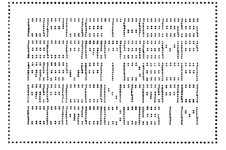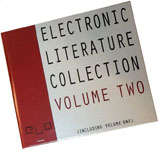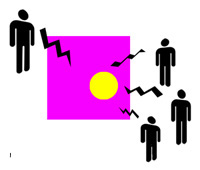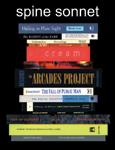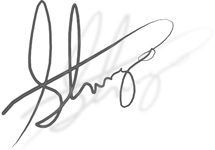The title of this exhibit could very well have been “Literary Experimentation from Print to Electronic” or “The Human Impulse toward Literary Expression,” or even “The Evolution of Literary Form,” for they all capture particular nuances that we convey with this show. But “Electronic Literature & Its Emerging Forms,” the title we have chosen, makes it clear that the exhibit focuses on the specific literary form of electronic literature and the way artists have experimented over time with it. The design of the exhibit lays bare this notion: On the one hand, the Library of Congress’s Whittall Pavilion is arranged so that the five Electronic Literature Stations are located in the prime location, i.e. the center of the room, underscoring electronic literature’s prominence as both concept and artifact; on the other, the display of print works comprising the five Context Stations showing connections to and contextualizing the experiments of artists creating for the electronic medium is organized to its left, hinting to chronology and antecedents of form. Creation Stations on the right hand side of the space suggest opportunities for visitors to engage actively with creating literary art.
As such, the exhibit builds on scholarship by Eduardo Kac and C. T. Funkhouser to make the argument––one expressed experientially rather than in written form––that electronic literature is a natural outgrowth of literary experimentation and human expression with roots in print literary forms and, so, constitutes an organic form generating from the dynamic human spirit that is evolving, will continue to evolve through time and medium. No matter the medium––orality, writing, print, electronic, mobile––give an artist something, anything, to create with––air, animal skin, paper, computer screen––and she or he will find a way to use it for making art. This impulse is, after all, a feature of our humanity.
But what is electronic literature?, you may ask. It is generally defined as a “digital born” literary work––that is, “a first generation digital object created on a computer and (usually) meant to be read on a computer” (Hayles 3). In a world dominated today by smart phones and tablets, the term computer has come to include also a computing device.
Electronic literature was not digital born yesterday but rather has been in existence for over five decades, starting with Théo Lutz’s 1959 computer generated poem, entitled “Stochastische Texte” (Kac 273; Funkhouser xix), and has been available commercially since the early 1990s with works published by Eastgate Systems. Its history has been inextricably linked to and enriched by experimentation generating from various art forms including literature, the visual arts, sonic art, performance, and cinema, and it is influenced by code and platforms associated with computer science. Thus, electronic literature is a hybrid art form that requires its readers to utilize various sensory modalities, such as sight, sound, touch, movement, when experiencing it. Just as one does not expect music to play when opening a book, one does come to expect it, for example, in web-based work like Erik Loyer’s “Strange Rain” or Thom Swiss’s “Shy Boy,” both found in this exhibit.
Within electronic literature one finds many genres––some of them reflected in this exhibit, like hypertext poetry, hypertext fiction, interactive fiction, kinetic poetry, generative text, interactive drama, to name a few. Key to understanding electronic literature is the construction of the genre’s name––that is, a mechanic feature complementing a traditional literary genre, i.e. hypertext and poetry, kinetic and poetry, interactive and drama. Function and form are rendered obvious in a way that we do not notice in print. So accustomed we have become to the technology of the book and writing that we no longer think of them as technology––but they are.
Despite being actually middle age, electronic literature is still relatively young in the eyes of the general public (and in comparison to print). However, recent articles and posts in Salon.com (“After e-literature, there’s no going back”) and The Huffington Post (i.e. “New Wor(l)d Order: E-lit Plays With Language”) and readings at The Kitchen in NYC in 2012 and 2013, along with its mainstreaming with traditional literature at the Modern Language Association and Association of Writers and Writing Programs go far in raising awareness of electronic literature. Likewise, the growth of the Digital Humanities, with its focus on new approaches to research and teaching, has helped to foster interest in it. In fact, this exhibit exists because of the intervention of digital humanist scholars, particularly Research Assistant Professor and THATCamp Coordinator at the Roy Rosenzweig Center for History and New Media at George Mason University Amanda French and the Library of Congress’s Susan Garfinkel, who were eager to see it “introduced” widely to a general public.
As Iwona Blazwick and Simon Wilson explain in Tate Modern: The Handbook, “Works of art are rarely encountered in isolation. They are experienced in relation to each other and articulated by the architectronics of a building and the unconscious choreography of other people” (31). This approach to curating sees the curator, art, space, and audience colluding to produce an exhibit. Years of curating also teach us that the curator is responsible for orchestrating as much of the experience as possible and, then, steps back, allowing the exhibit to unfold. In the case of the Library of Congress, foundational as it is to American culture and the literary arts, the curator must make a mindful connection to the vast riches that the Library houses and match the beauty and grandeur of the space it inhabits.
The Library of Congress’s mission as the center of learning is clear: “to further the progress of knowledge and creativity for the benefit of the American people.” What better way to demonstrate this concept of “progress” than with an exhibit focusing on what can only be called innovative literature and its evolution from print to electronic for both desktop and mobile environments?
The curatorial design of “Electronic Literature & Its Emerging Forms” responds to this mission. We have organized the exhibit into three main sections that, taken together, make the argument that literature is a natural outgrowth of literary experimentation and human expression with roots in print literary forms and, so, constitutes an organic form generating from the dynamic human spirit that is evolving, will continue to evolve through time and medium. Media from the Library’s collections are displayed on five “Context Stations” located on the left hand side of the space; electronic literature, displayed on five “Electronic Literature Stations” situated in the middle of space; and finally, materials provided for hands-on workshops on “Creation Stations,” available on the right hand side of the space. As mentioned previously, the Context Stations are envisioned to show connections to and contextualize the experiments found on the Electronic Literature Stations. These stations are organized to the left, hinting to chronology and antecedents of form, and the Creation Stations suggest opportunities for visitors to engage actively with creating literary art, both print and electronic.
Showing the relationship between electronic literature and literary experiments generating from the print medium goes far in establishing electronic literature as a natural outgrowth of artistic experimentation not unlike that which has occurred in the print medium, e.g. cut up poetry or artist books. The collections of works selected for exhibit along with electronic literary works, such as books, manuscripts, and other artifacts, offer a wealth of resources that help us make this case. The Library’s edition of Laurence Sterne’s Tristam Shandy, on view from the Rare Book and Special Collections on Thursday, April 4, a novel criticized at the time of its publication for plagiarism, suggests remixing source texts. This concept is connected to Jody Zellen’s “Spine Sonnet,” located on Electronic Literature Station #3, a generative poem that remixes titles of books found on their spine into sonnets.
Additionally, the exhibit is located in the Whittall Pavilion on the ground floor of the Thomas Jefferson Building, certainly one of the most elaborately decorative buildings of the 19th century. Thinking through the layout and design of the space has prodded us to consider such details as using large screen iMacs for displaying the works and selecting specific colors for the wallpaper for computer screens. All aesthetic decisions made about this exhibit have been thought through and carefully considered.
Most importantly, the conceptual framework developed for the exhibit has informed all decisions for the selection of works. The Library of Congress’s stature as the nation’s library makes it apparent that the exhibit should focus on major American artists and influential pioneers working in any language and whose art fits the classic definition of electronic literature. The Library’s appeal to a wide audience with more than 1.7 million onsite visitors each year and more than 77 million visits and 581.1 million page views on the it website means that the works chosen need to reflect a broad spectrum of genres and approaches, e.g. kinetic poetry, hypertext fiction, animated graphic novels, augmented reality environments. Finally, common to all works is the quality of “literariness,” whether it be articulated through the use of language, the presence of narrative or poetic elements, or as Hayles refers to as “creative artworks that interrogate the histories, contexts, and productions of literature, including as well the verbal art of literature proper” (4).
Eduardo Kac, “Nao!” (1982/84)
Dan Waber, “Strings” (1999)
Thom Swiss, “Shy Boy” (2002)
Robert Kendall, “Faith” (2002 )
A. J. Patrick Liszkiewicz, “Afeeld” (2010)
The affordances the electronic medium, particularly broadband internet access and graphical user interface (GUI) browsers like Netscape, made it possible for computers to display and disseminate works that featured movement and sound. These innovations provided the opportunity for electronic literature artists to animate concrete poetry and distribute it online to large audiences. This station highlights such experiments, beginning with Eduardo Kac’s “Nao!,” originally presented as an electronic sign board, then, later offered online. The works by Waber, Swiss, and Kendall were produced at the height of net art’s (short for “internet net”) popularity in the first decade of the 21st century, and Liszkiewicz’s at its end. The introduction of smart mobile devices in the latter part of the decade provided new outlets of expression for artists creating kinetic poetry but also posed a challenge to those using Flash software because the Apple Corporation chose not to support it on the iPhone and iPad. None of these works, in their current format, are available on Apple smart mobile devices.
Michael Joyce, afternoon: a story (1990)
Stuart Moulthrop, Victory Garden (1991)
Judy Malloy, its name was Penelope (1993)
Jennifer T. Ley, The Body Politic (1999)
M.D. Coverley, Egypt: The Book of Going Forth by Day (2006)
Stephanie Strickland, “slippingglimpse” (2007)
“I want to say I may have seen my son die today.” This poignant line from Michael Joyce’s hypertext novel, afternoon: a story, can easily be missed considering the story is broken up into 539 different chunks of text (called “lexias”) organized as nodes, with thousands of links providing multiple pathways to them. Thus, the story can be configured as the reader chooses. The concept of hypertext comes to us from Theodor (Ted) Nelson who saw literature as “a system of interconnected writings.” He himself was influenced by William S. Burroughs who viewed “the reading experience as one of entering into a multi-directional web of different voices, ideas, perceptions, and periods of time” and “the cut-up as a tool that let the writer discover previously undetected connections between things, with potentially enlightening and subversive results” (Packer & Jordan). Station 2 features six different hypertext works created over a 17 year time period, from 1990 to 2007. All make bold use of hypertext’s promise.
Nick Montfort, “Ad Verbum” (2000)
Emily Short, “Galatea” (2000)
Jason Nelson, “Game, game, game and again game” (2007)
Alan Bigelow, “This Is Not a Poem,” (2010)
Jason Edward Lewis, P.O.E.M.M. Cycle (2011)
Jody Zellen, “Spine Sonnet” (2012)
Mark Marino, “Living Will” (2012)
Against a black screen, a white ball bounces as you hit it with your white paddle. It is 1975, and you are playing Pong, the video game that gives birth to the video game industry. It was not much of a leap for literary artists exposed to such games to see their potential as a medium for telling stories or making poetry. The concept of the literary game has long existed throughout our cultural history. The literary riddle, like the one posed by the sphinx in Sophocles’ Oedipus, provides one such example. Thus, the notion of literary games is not an oxymoron. It constitutes a form that provides us “ludic pleasure” (Montfort 2). All of the works shown here, from Montfort’s and Short’s interactive fiction, to Nelson’s and Bigelow’s satirical and gameful net art, to Lewis’s and Zellen’s playful mobile apps, to Marino’s acerbic political commentary, show the breath of possibilities that literary games offer.
Rand Miller, Robyn Miller, & David Wingrove, Myst (1993)
Ingrid Ankerson & Megan Sapnar, “Cruising” (2001)
Michael Mateus & Andrew Stern, Façade (2005)
Evan Young & Geoffrey Young, The Carrier (2009)
Steve Tomasula, TOC the Novel (2009)
F. Scott Fitzgerald said, “An author ought to write for the youth of his own generation, the critics of the next, and the schoolmasters of ever after.” It is this notion of writing to one’s generation, of capturing the zeitgeist of American cultural history, that gave rise to the pursuit of the Great American Novel. The benchmark of talent and vision of an artist, the Great American Novel has been attributed to many books, including Fitzgerald’s own The Great Gatsby. Electronic literature artists have also produced long narrative fiction that fits this genre. Myst, The Carrier, and TOC the Novel constitute such examples. “Cruising” and Façade provide points of comparison. “Cruising” is a short spoken word poem about cruising the strip of suburban America. The interactive narrative Façade experiments with 1st person narrative common to many video games. All incorporate multimedia, making reading a rich multisensory experience. Other works in this exhibit––Joyce’s afternoon: a story, Moulthrop’s Victory Garden, Coverley’s Egypt––may also be viewed as examples of the Great American Novel in this early age of digital literary art.
Talan Memmott, Lexia to Perplexia (2000)
Erik Loyer, “Strange Rain” (2010)
Electronic Literature Collection 2, [“book” format] (2011)
Amaranth Borsuk & Brad Bouse, Between Page and Screen (2012)
Through her interactions with artists’ books, N. Katherine Hayles makes the connection between materiality and content, arguing that “electronic textuality could be brought into focus by comparing it to print, just as the conventions, materiality, and specificities of print could become more apparent by comparing them to electronic work” (Writing Machines 65). Memmott’s, Loyer’s, and Borsuk and Bouse’s electronic literary art, featured at this station, may be viewed as an electronic version of an artists’ book in that they possess a strong design aesthetic and a unique realization of the medium. Combined with the playful use of language, they delight and compel us to engage with them. The Electronic Literature Collection 2 has been included in this exhibit because of its material presentation. A small, seemingly hand-made book opens to a flash drive, housed within, that contains 63 works of electronic literature, thus surprising the reader with the juxtaposition of print and digital artifact.
As visitors experience the exhibit and see the connections made between past and present works of literary art––where it has come from and where it has arrived––we invite them to think about where it is headed. Literature is, like all of us, dynamic. Creator and the created, both evolving and emerging forms, organic and alive, always in a state of becoming.
Blazwick, Iwona and Wilson, Simon. Tate Modern: The Handbook. London, Tate Publishing, 2000.
Chamber, Roland. “After e-literature, there’s no going back.” Salon.com. 29 Oct. 2012. http://www.salon.com/2012/10/29/after_e_literature_theres_no_going_back/.
Fitzgerald, F. Scott. “Letter to Booksellers’ Convention,” April 1920.
Funkhouser, C. T. Prehistoric Digital Poetry: An Archaeology of Forms, 1959-1995. Tuscaloosa, AL: The University of Alabama Press, 2007.
Hayles, N. Katherine. Electronic Literature: New Horizons for the Literary. Notre Dame, IN: Notre Dame Press, 2008.
—. Writing Machines. Cambridge, MA: The MIT Press, 2002.
Kac, Eduardo. Media Poetry: An Anthology. Bristol, UK: Intellect Press, 2007.
Montfort, Nick. Twisty Little Passages: An Approach to Interactive Fiction. Cambridge, MA: The MIT Press, 2003.
Nelson, Theodor. Literary Machines. 1984. 2.
Packer, Randall & Ken Jordan. Multimedia: From Wagner to virtual Reality. NY, NY: W.W. Norton & Co., 2002. http://www.w2vr.com/overture/datawork.html.
Szilak, Illya. New Wor(l)d Order: E-lit Plays With Language. The Huffington Post. 7 Feb. 2013. http://www.huffingtonpost.com/illya-szilak/digital-literature_b_2605389.html.
